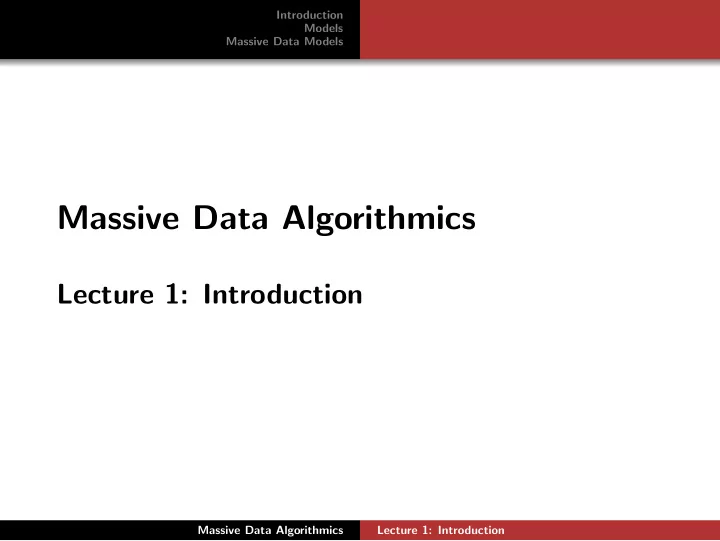

Introduction Models Massive Data Models Massive Data Algorithmics Lecture 1: Introduction Massive Data Algorithmics Lecture 1: Introduction
Introduction Massive Data Models Examples Massive Data Models Massive Data Massive datasets are being collected everywhere Storage management software is billion-dollar industry Massive Data Algorithmics Lecture 1: Introduction
Introduction Massive Data Models Examples Massive Data Models Examples Phone: AT&T 20TB phone call database, wireless tracking Consumer: WalMart 70TB database, buying patterns WEB: Web crawl of 200M pages and 2000M links, Akamai stores 7 billion clicks per day Geography: NASA satellites generate 1.2TB per day Massive Data Algorithmics Lecture 1: Introduction
Introduction Massive Data Models Examples Massive Data Models Grid Terrain Data Appalachian Mountains (800km x 800km) 100m resolution ⇒ ∼ 64M cells ⇒ ∼ 128MB raw data ( ∼ 500MB when processing) ∼ 1.2GB at 30m resolution NASA SRTM mission acquired 30m data for 80% of the earth land mass ∼ 12GB at 10m resolution (much of US available from USGS) ∼ 1.2TB at 1m resolution (selected, mostly military) Massive Data Algorithmics Lecture 1: Introduction
Introduction Massive Data Models Examples Massive Data Models LIDAR Terrain Data Massive (irregular) point sets (1-10m resolution) Appalachian Mountains between 50GB and 5TB Massive Data Algorithmics Lecture 1: Introduction
Introduction Massive Data Models Examples Massive Data Models Application Example: Flooding Prediction Massive Data Algorithmics Lecture 1: Introduction
Introduction Random access Models Hierarchical Memory Massive Data Models Random Access Machine Model Standard theoretical model of computation: Infinite memory Uniform access cost Simple model crucial for success of computer industry Massive Data Algorithmics Lecture 1: Introduction
Introduction Random access Models Hierarchical Memory Massive Data Models Hierarchical Memory Modern machines have complicated memory hierarchy Levels get larger and slower further away from CPU Data moved between levels using large blocks Massive Data Algorithmics Lecture 1: Introduction
Introduction Random access Models Hierarchical Memory Massive Data Models Slow IO Disk access is 10 6 times slower than main memory access The difference in speed between modern CPU and disk technologies is analogous to the difference in speed in sharpening a pencil using a sharpener on ones desk or by taking an airplane to the other side of the world and using a sharpener on someone elses desk. (D. Comer) Disk systems try to amortize large access time transferring large contiguous blocks of data (8-16Kbytes) Important to store/access data to take advantage of blocks (locality) Massive Data Algorithmics Lecture 1: Introduction
Introduction Random access Models Hierarchical Memory Massive Data Models Scalability Problems Most programs developed in RAM-model. Run on large datasets because OS moves blocks as needed Moderns OS utilizes sophisticated paging and prefetching strategies. But if program makes scattered accesses even good OS cannot take advantage of block access Massive Data Algorithmics Lecture 1: Introduction
IO Model Introduction Cache-Oblivious Model Models Streaming Model Massive Data Models Evaluation External Memory Model(Cache-Aware Model) N = # of items in the problem instance B = # of items per disk block M = # of items that fit in main memory T = # of items in output I/O: Move block between memory and disk We assume (for convenience) that M > B 2 Massive Data Algorithmics Lecture 1: Introduction
IO Model Introduction Cache-Oblivious Model Models Streaming Model Massive Data Models Evaluation Fundamental Bounds Internal External Scanning N / B N Sorting N log N N / B log M / B N / B Permuting min ( N , N / B log M / B N / B ) N Searching log N log B N Note: Linear I/O: O ( N / B ) Permuting not linear Permuting and sorting bounds are equal in all practical cases B factor VERY important: N / B < ( N / B ) log M / B ( N / B ) << N Massive Data Algorithmics Lecture 1: Introduction
IO Model Introduction Cache-Oblivious Model Models Streaming Model Massive Data Models Evaluation Cache-Oblivious Model A cache-oblivious algorithm is an algorithm designed to take advantage of a CPU cache without having the size of the cache a cache oblivious algorithm is designed to perform well, without modification, on multiple machines with different cache sizes, or for a memory hierarchy with different levels of cache having different sizes. The idea for cache-oblivious algorithms was conceived by Charles E. Leiserson as early as 1996 and first published by Harald Prokop in his master’s thesis at the Massachusetts Institute of Technology in 1999. Massive Data Algorithmics Lecture 1: Introduction
IO Model Introduction Cache-Oblivious Model Models Streaming Model Massive Data Models Evaluation Streaming Model In stream model, input data are not available for random access from disk or memory, but rather arrive as one or more continuous data streams. Performance of algorithm is measured by three basic factors: Number of passes algorithm must make over stream. The available memory. The running time of the algorithm. Massive Data Algorithmics Lecture 1: Introduction
IO Model Introduction Cache-Oblivious Model Models Streaming Model Massive Data Models Evaluation Grading Midterm: 6 points Final: 6 points 2-3 project+exercise: 3 points Presentation: 2 points Report: 3 points Massive Data Algorithmics Lecture 1: Introduction
Recommend
More recommend